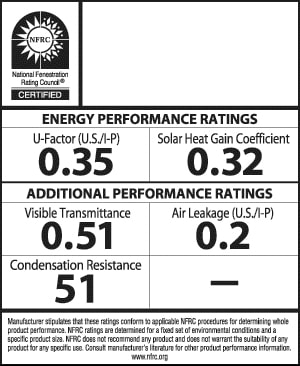Energy efficiency. It’s one of the main reasons that most Livermore homeowners decide to purchase replacement windows. Almost all of the replacement window products on the market claim to be energy efficient, and they can do so because they are typically more energy efficient than the old, drafty, single pane windows you may currently have in your home.
So, if all new windows are energy efficient, shouldn’t you just choose the most inexpensive option? Well, not necessarily. One energy-efficient window can be much better than another, even if they are made by the same manufacturer.
Fortunately, for replacement window shoppers, there is an easy way to compare the energy efficiency of replacement window products, even among windows made by different manufacturers. The National Fenestration Rating Council (NFRC), an independent nonprofit organization that tests the energy performance of window and door products, rates windows and doors in several categories so you can effectively compare “apples to apples.”
Unfortunately, the terms used in the NFRC rating system are not ones you are probably familiar with, and even if you are, the numbered ratings given in each category require a bit of explanation. In this blog post, we’ll do our best to break down the various replacement window rating categories, so you know what to look for when shopping for energy-efficient windows and can easily compare the energy efficiency of the various products you are considering.
U-Factor
The U-Factor number is important because it tells you how good a replacement window product is at keeping heat from escaping your home. If you find yourself running your heater a lot in the cold winter months, windows with a good U-Factor rating should be something you look for. So, what is a good U-Factor rating? U-Factor ratings fall on a scale from 0.20 to 1.20. A window product with a low U-Factor number is more desirable and will keep you home better insulated from the cold.
Solar Heat Gain Coefficient (SHGC)
The SHGC rating on a window tells you how well the window product will keep heat out of your home. Installing windows with a good SHGC rating is important for homes in areas that experience hot summer months, since this will allow homeowners to use less energy cooling their homes. SHGC is measured on a scale of 0 to 1, with a lower number being better.

If you’re like many Livermore homeowners, you may have some rooms in your home that get hotter in the summer than others. Maybe you have rooms that receive direct afternoon sunlight or that don’t have as much insulation. You could have windows with a very low SHGC rating installed in just those rooms, and windows with a slightly higher SHGC rating installed in the rest of your home, which will save you money over installing windows with a very low SHGC rating in your entire home.
Visible Transmittance
The Visible Transmittance (VT) number indicates how well a window product will naturally light your home. A window with a high VT number (on a scale of 0 to 1) will allow in more light, and could potentially save you money, since you won’t have to use as much artificial lighting. Conversely, if you have a room in which you don’t want to let in a lot of light (or glare), such as a media room, you would want to choose replacement window products with a low VT number.
Air Leakage
You can probably guess what the Air Leakage ratings measure—the amount of air that is allowed to enter your home through a window. Air Leakage ratings fall on a scale of 0.1 to 0.3. A lower Air Leakage number will allow fewer drafts to enter your Livermore home.
What About ENERGY STAR Windows?
Windows qualify as ENERGY STAR products when they have U-Factor and SHGC numbers that are lower than or equal to the ratings established by the ENERGY STAR program, which is a program of the U.S. Environmental Protection Agency (EPA). Purchasing ENERGY STAR windows may qualify you for certain government rebates available to Livermore homeowners, and will also give you reassurance that the windows you are purchasing are actually energy efficient.
So where do you find all of the ratings mentioned above? Any replacement window dealer should be able to provide you with these numbers. You can also look online at the various window manufacturers’ websites, and they should have that information listed. For example, for Monte Verde replacement windows, you can find that information here.
A Custom Exchange team member would also be happy to help you compare replacement window products and find the most energy-efficient products that meet your needs and fit within your budget Contact us today to schedule an in-home consultation with one of our helpful, knowledgeable team members.






